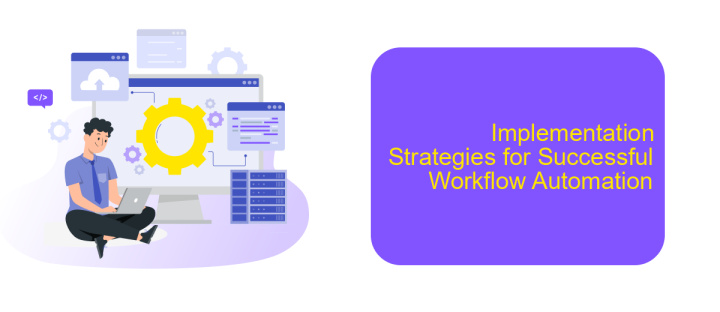Streamlined Workflow Automation
In today's fast-paced business environment, streamlined workflow automation is essential for maintaining efficiency and competitiveness. By automating repetitive tasks and optimizing processes, companies can reduce human error, save time, and allocate resources more effectively. This article explores the benefits, key strategies, and tools for implementing workflow automation to enhance productivity and drive business success.
Introduction: The Imperative for Workflow Automation
In today's fast-paced business environment, the need for streamlined workflow automation has never been more critical. Organizations are constantly seeking ways to enhance efficiency, reduce manual errors, and improve overall productivity. By automating repetitive tasks, businesses can allocate more resources to strategic initiatives, driving growth and innovation.
- Increased operational efficiency
- Reduction in human error
- Enhanced collaboration and communication
- Cost savings and resource optimization
One of the key components of effective workflow automation is the integration of various tools and platforms. Services like ApiX-Drive facilitate seamless integration, enabling businesses to connect disparate systems effortlessly. This not only streamlines processes but also ensures data consistency and accuracy across the organization. As a result, companies can achieve higher levels of productivity and maintain a competitive edge in the market.
Benefits of Streamlined Workflow Automation

Streamlined workflow automation offers numerous benefits, significantly enhancing operational efficiency and productivity. By automating repetitive tasks, businesses can reduce the likelihood of human error, ensuring more consistent and accurate results. This not only saves time but also allows employees to focus on more strategic and creative tasks, fostering innovation and growth within the organization. Additionally, automated workflows can be easily scaled to accommodate business growth, making them a flexible solution for companies of all sizes.
Another key advantage of streamlined workflow automation is the seamless integration of various tools and systems. Services like ApiX-Drive facilitate the connection between different applications, enabling smooth data transfer and synchronization. This integration capability ensures that all business processes are interconnected, providing a holistic view of operations and improving decision-making. By leveraging tools like ApiX-Drive, businesses can create a more cohesive and efficient workflow, ultimately leading to enhanced performance and competitive advantage.
Key Features of Effective Workflow Automation Tools

Effective workflow automation tools are essential for optimizing business processes, enhancing productivity, and reducing manual errors. These tools offer a range of features that streamline operations and ensure seamless integration across various platforms.
- Integration Capabilities: The ability to connect with various apps and services is crucial. Tools like ApiX-Drive facilitate seamless integration, allowing data to flow effortlessly between different systems.
- Customizable Workflows: Flexibility in designing and modifying workflows to meet specific business needs ensures that the tool can adapt to any operational requirement.
- Real-Time Monitoring: Real-time tracking and analytics provide insights into workflow performance, helping to identify bottlenecks and optimize processes.
- User-Friendly Interface: An intuitive interface simplifies the setup and management of workflows, making it accessible for users with varying technical expertise.
- Scalability: The tool should be able to scale with the growth of the business, handling increasing volumes of data and complex workflows efficiently.
By incorporating these key features, workflow automation tools can significantly enhance operational efficiency and drive business success. Choosing the right tool, such as ApiX-Drive for integration needs, can make a substantial difference in achieving streamlined workflows.
Implementation Strategies for Successful Workflow Automation

Implementing successful workflow automation requires a structured approach to ensure efficiency and effectiveness. The first step involves identifying repetitive tasks that can be automated, thus freeing up valuable human resources for more strategic activities. This step is crucial as it sets the foundation for the entire automation process.
Once the tasks are identified, the next step is to choose the right tools and platforms. Selecting a versatile and reliable automation tool like ApiX-Drive can significantly streamline the process. ApiX-Drive allows seamless integration of various applications, ensuring that data flows smoothly between systems without manual intervention.
- Identify repetitive tasks suitable for automation
- Select the appropriate automation tools
- Integrate systems using a platform like ApiX-Drive
- Test and monitor the automated workflows
Finally, continuous monitoring and optimization are essential to maintain the efficiency of automated workflows. Regularly reviewing the performance and making necessary adjustments can help in addressing any issues promptly and ensuring that the automation continues to deliver the desired results.
Case Studies and Best Practices
One notable case study involves a mid-sized e-commerce company that successfully implemented streamlined workflow automation to enhance their order processing system. By integrating ApiX-Drive, they were able to connect multiple platforms such as their online store, CRM, and email marketing tools seamlessly. This integration not only reduced manual data entry but also ensured real-time updates across all systems, leading to a 30% increase in operational efficiency and a significant reduction in human errors.
Another best practice example comes from a financial services firm that automated their client onboarding process. Utilizing ApiX-Drive, they connected their CRM with document management and e-signature services, creating a cohesive and automated workflow. This resulted in a 40% faster onboarding process, improved client satisfaction, and better compliance with regulatory requirements. These case studies demonstrate the transformative potential of workflow automation and the critical role of effective integration tools like ApiX-Drive in achieving business efficiency.
FAQ
What is workflow automation?
How can workflow automation benefit my business?
What types of processes can be automated?
How do I get started with workflow automation?
Is it difficult to set up workflow automation?
Apix-Drive is a universal tool that will quickly streamline any workflow, freeing you from routine and possible financial losses. Try ApiX-Drive in action and see how useful it is for you personally. In the meantime, when you are setting up connections between systems, think about where you are investing your free time, because now you will have much more of it.

